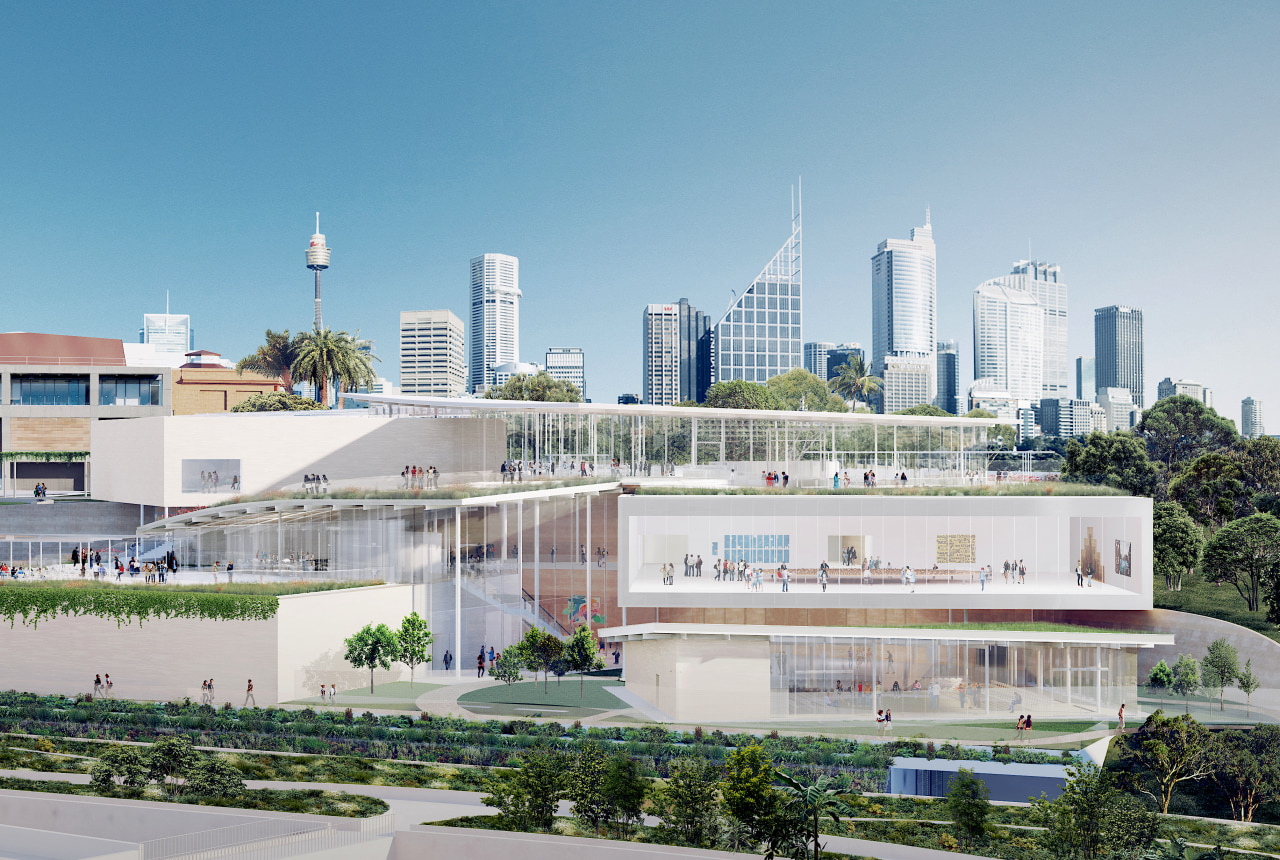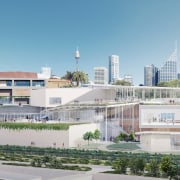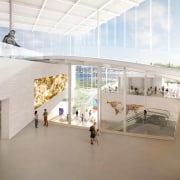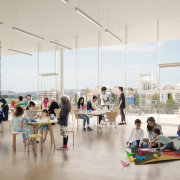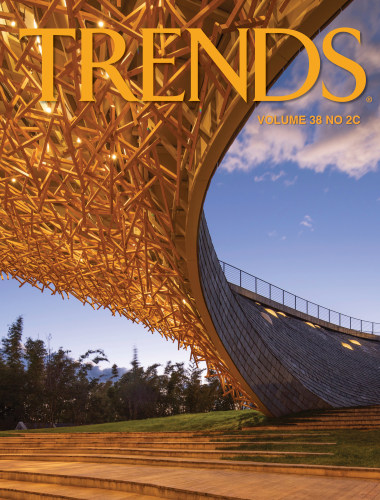Art for the people's sake
Designed by Pritzker Prize-winning architects SANAA, the Sydney Modern Project is the city's most significant cultural development since the Sydney Opera House
Designed by SANAA
From the architects:
The Art Gallery of New South Wales sits on the gentle slope of Sydney’s Domain parkland, a spectacular site adjacent to the Royal Botanic Garden overlooking Sydney Harbour.
The Art Gallery has grown gradually over the past century, with a number of extensions built to accommodate an increasingly diverse art collection.
Principle elements
The Sydney Modern Project almost doubles the Art Gallery's exhibition space and includes a spectacular new building designed by Pritzker Prize-winning Japanese architects SANAA, with Australian practice Architectus as executive architect.
Also part of the project is revitalisation of the Art Gallery's historic building by Australian architects Tonkin Zulaikha Greer, including a complete re-installation of the collection.
Lastly, there are extensive outdoor art experiences, and a series of major art commissions across the campus by leading international and Australian artists.
Sydney Modern Project
The Sydney Modern Project is a new standalone building to the north of the existing Gallery building, at the junction between several critical pathways.
Pedestrians cross the site to go to and from the city, while cars run along an expressway below.
The terrain of the site is diverse. There is a 20m rise from the harbour to Art Gallery Road, where the Art Gallery’s front door is located.
Adjacent is a land bridge that connects the Art Gallery to the Botanic Garden.
At the lowest level of the site are two decommissioned oil tanks that were used during the Second World War.
These tanks, roads, and the land-bridge are all part of Sydney’s history.
The new building is composed of a series of pavilions of various sizes and gallery volumes, which sit lightly across these elements.
The low roofs step and shift gently along this topography to preserve existing significant trees, sight lines, and the contour of the site.
Connecting the existing and new gallery buildings is a civic plaza – the Welcome Plaza – a shaded outdoor area connected to the entrance pavilion of the new building that acts as a shared space for the community.
It is a large open plaza into which many activities can spill simultaneously.
We envision a space where visitors and school groups can gather casually, meet new people and prepare for their visit to the Art Gallery.
From inside the entrance pavilion, visitors can then see down into an atrium, glimpsing art, activities, and landscape beyond.
Exhibition spaces are spread across the various levels of the building.
The Aboriginal and Torres Strait Islander gallery
The Aboriginal and Torres Strait Islander gallery is on the entrance level with a glazed wall facing the existing building and a window with a view of the harbour.
At the lowest level, the southern oil tank has been preserved and adapted to house major art commissions and installations.
Visitors are led slowly downward through the site, bringing them closer to the harbour.
Three central roofs are accessible, creating linking terraces and offering additional views across the precinct.
Circulation both inside and out follows organic paths that resonate with the existing terrain.
By integrating art, the topography of the site, and the surrounding landscape, we hope to create a gallery experience that is distinctive to Sydney.
The Art Gallery is the first public art museum in Australia to achieve the highest environmental standard for design and the Sydney Modern Project has been awarded a 6-star Green Star design rating by the Green
Building Council of Australia. Classified as ‘world leadership’ in sustainability, the rating exceeds the Gallery’s original 5-star goal and sets a new standard for art museums globally.
Expanded horizons
The design delivers much-needed gallery space while respecting and enhancing public use of the surrounding landscape, retaining and celebrating significant trees and improving the accessibility of the cultural precinct.
The new building also comprises art research and education spaces, multipurpose spaces, shop, food and beverage facilities, and visitor amenities.
New art spaces in the SANAA-designed building include:
- Dedicated gallery to showcase Aboriginal and Torres Strait Islander art: 960m² with 5.5m high ceiling
- Large major exhibition gallery: 1300m² with 5.5m-high ceiling
- Large column-free gallery: 1100m² with 5.5m-high ceiling
- Oil tank gallery: 2200m² gallery with 7m-high ceiling
- Smaller galleries, including a project gallery, new media gallery and media lab
- Purpose-built learning and participation studios for younger audiences
- Flexible multipurpose spaces for public programs, performance and lectures
- Accessible roof ‘art terraces’ and courtyards: 3400m²
Key facts
Approximately 70% of the new gallery is being constructed above existing structures – the land bridge built in 1999 and the concrete roof over two decommissioned WWII naval oil tanks built in the early 1940s.
Adaptive re-use of the tanks will enable public access to a significant State asset for the first time.
The expansion delivers new open green spaces across the site, including the outdoor public art garden and new civic plaza linking the new and existing buildings.
These publicly accessible external spaces comprise close to 80% of the site, including more than 3400m² of accessible roof ‘art terraces’ and courtyards.
The project will increase biodiversity with 70% more trees on site.
Significant landscape design will use endemic ecological planting (Sydney Sandstone Woodland) and reinstate historic species associated with the ‘Governor’s Domain’, more in keeping with the site’s original flora.
The external facade material of the pavilions of natural limestone in warm tones and two sweeping internal walls of rammed earth in the new building are sympathetic to the sandstone facade of the existing building and parkland setting of The Domain.
Sustainability
The Art Gallery is committed to sustainability and has worked extensively with SANAA and the project consultant team to ensure the design maximises open space across the site, integrating the
building with the landscape. Key sustainable design initiatives include:
• Solar panels: more than 1,500 sqm of photovoltaic cells over the Entrance Pavilion that will contribute approximately 10% of the new building’s estimated annual energy requirements
• Water efficiency and rainwater harvesting: the landscaped roof areas of the new building will capture rainwater, which will be reused in the existing building’s cooling towers and for on-site irrigation
• Green roofs
• Maximising natural daylight
On Gadigal land
The Art Gallery of New South Wales acknowledges the traditional custodians of the land on which it is located, the Gadigal people of the Eora nation, and recognises their continuing connection to land, waters and culture.
In the world's eyes
Dr. Michael Brand, Director, Art Gallery of New South Wales: "Our new art museum campus brings together art, architecture and landscape in spectacular new ways, providing visitors with art and cultural experiences only possible here. This is truly the world seen from Sydney.”
Opening
The transformation of the Art Gallery of New South Wales will open to the public on Saturday 3, December 2022.
Credit list
Project
Executive architect
Construction
Home kitchen bathroom commercial design
Yellow wattle blooming
Cottagy entwines contemporary
Nature infused
